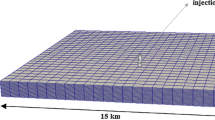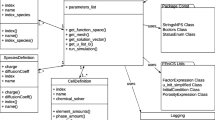Abstract
A benchmark problem set consisting of four problem levels was developed for the simulation of Cr isotope fractionation in 1D and 2D domains. The benchmark is based on a recent field study where Cr(VI) reduction and accompanying Cr isotope fractionation occurs abiotically by an aqueous reaction with dissolved Fe 2+ (Wanner et al., 2012., Appl. Geochem., 27, 644–662). The problem set includes simulation of the major processes affecting the Cr isotopic composition such as the dissolution of various Cr(VI) bearing minerals, fractionation during abiotic aqueous Cr(VI) reduction, and non-fractionating precipitation of Cr(III) as sparingly soluble Cr-hydroxide.
Accuracy of the presented solutions was ensured by running the problems with four well-established reactive transport modeling codes: TOUGHREACT, MIN3P, CRUNCHFLOW, and FLOTRAN. Results were also compared with an analytical Rayleigh-type fractionation model. An additional constraint on the correctness of the results was obtained by comparing output from the problem levels simulating Cr isotope fractionation with the corresponding ones only simulating bulk concentrations. For all problem levels, model to model comparisons showed excellent agreement, suggesting that for the tested geochemical processes any code is capable of accurately simulating the fate of individual Cr isotopes.
Similar content being viewed by others
References
Kotas, J., Stasicka, Z.: Chromium occurrence in the environment and methods of its speciation. Environ. Pollut. 107, 263–283 (2000)
Oze, C., Bird, D.K., Fendorf, S.: Genesis of hexavalent chromium from natural sources in soil and groundwater. Proc. Natl. Acad. Sci. U. S. A. 104, 6544–6549 (2007)
Szalinska, E., Dominik, J., Vignati, D.A.L., Bobrowski, A., Bas, B.: Seasonal transport pattern of chromium(III and VI) in a stream receiving wastewater from tanneries. Appl. Geochem. 25, 116–122 (2010)
Rai, D., Sass, B.M., Moore, D.A.: Chromium(III) hydrolysis constants and solubility of chromium(III) hydroxide. Inorg. Chem. 26, 345–349 (1987)
Powell, R.M., Puls, R.W., Hightower, S.K., Sabatini, D.A.: Coupled iron corrosion and chromate reduction: mechanisms for subsurface remediation. Environ. Sci. Technol. 29, 1913–1922 (1995)
Palmer, C.D., Puls, R.: W. Iron Metal for Subsurface Remediation; EPA/540/S-94/505; U.S. EPA Ground Water Issue (1994)
Naftz, D.L., Morrison, S.J., Davies, J.A., Fuller, C.C.: Handbook of Groundwater remediation using permeable reactive barriers. Elsevier Science, San Diego, USA (2002)
Flury, B., Frommer, J., Eggenberger, U., Mäder, U., Nachtegaal, M., Kretzschmar, R.: Assessment of long-term performance and chromate reduction mechanisms in a field scale permeable reactive barrier. Environ. Sci. Technol. 43, 6786–6792 (2009)
Wanner, C., Zink, S., Eggenberger, U., Mäder, U.: Assessing the Cr(VI) reduction efficiency of a permeable reactive barrier using Cr isotope measurements and 2D reactive transport modeling. J. Cotam. Hydrol. 131, 54–63 (2012)
Faybishenko, B., Hazen, T.C., Long, P.E., Brodie, E.L., Conrad, M.E., Hubbard, S.S., Christensen, J.N., Joyner, D., Borglin, S.E., Chakraborty, R., Williams, K.H., Peterson, J.E., Chen, J., Brown, S.T., Tokunaga, T.K., Wan, J., Firestone, M., Newcomer, D.R., Resch, C.T., Cantrell, K.J., Willett, A., Koenigsberg, S.: In Situ long-term reductive bioimmobilization of Cr(VI) in Groundwater using hydrogen release compound. Environ. Sci. Technol. 42, 8478–8485 (2008)
Wanner, C., Zink, S., Eggenberger, U., Mäder, U.: Unraveling the partial failure of a permeable reactive barrier using a multi-tracer experiment and Cr isotope measurements. Appl. Geochem. 37, 125–133 (2013)
Zink, S., Schoenberg, R., Staubwasser, M.: Isotopic fractionation and reaction kinetics between Cr(III) and Cr(VI) in aqueous media. Geochim. Cosmochim. Acta 74, 5729–5745 (2010)
Basu, A., Johnson, T.M.: Determination of Hexavalent chromium reduction using cr stable isotopes: isotopic fractionation factors for permeable reactive barrier materials. Environ. Sci. Technol. 46, 5353–5360 (2012)
Kitchen, J.W., Johnson, T.M., Bullen, T.D., Zhu, J., Raddatz, A.L.: Chromium isotope fractionation factors for reduction of Cr(VI) by aqueous Fe(II) and organic molecules. Geochim. Cosmochim, Acta (2012)
Jamieson-Hanes, J.H., Gibson, B.D., Lindsay, M.B.J., Kim, Y., Ptacek, C.J., Blowes, D.W.: Chromium Isotope fractionation during reduction of cr(vi) under saturated flow conditions. Environ. Sci. Technol. 46, 6783–6789 (2012)
Izbicki, J.A., Ball, J.W., Bullen, T.D., Sutley, S.J.: Chromium, chromium isotopes and selected trace elements, western Mojave Desert, USA. Appl. Geochem. 23, 1325–1352 (2008)
Berna, E.C., Johnson, T.M., Makdisi, R.S., Basu, A.: Cr stable isotopes as indicators of Cr(VI) reduction in groundwater: a detailed time-series study of a point-source plume. Environ. Sci. Technol. 44, 1043–1048 (2010)
Wanner, C., Eggenberger, U., Kurz, D., Zink, S., Mäder, U.: A chromate-contaminated site in southern Switzerland, part 1: site characterization and the use of Cr isotopes to delineate fate and transport. Appl. Geochem. 27, 644–654 (2012)
Izbicki, J.A., Bullen, T.D., Martin, P., Schroth, B.: Delta Chromium-53/52 isotopic composition of native and contaminated groundwater, Mojave Desert, USA. Appl. Geochem. 27, 841–853 (2012)
Ellis, A.S., Johnson, T.M., Bullen, T.D.: Chromium isotopes and the fate of hexavalent chromium in the environment. Science 295, 2060–2062 (2002)
Wanner, C., Sonnenthal, E.L.: Assessing the control on the effective kinetic Cr isotope fractionation factor: a reactive transport modeling approach. Chem. Geol. 337, 88–98 (2013)
Dossing, L.N., Dideriksen, K., Stipp, S.L.S., Frei, R.: Reduction of hexavalent chromium by ferrous iron: a process of chromium isotope fractionation and its relevance to natural environments. Chem. Geol. 285, 157–166 (2011)
Sikora, E.R., Johnson, T.M., Bullen, T.D.: Microbial mass-dependent fractionation of chromium isotopes. Geochim. Cosmochim. Acta 72, 3631–3641 (2008)
DePaolo, D.J.: Surface kinetic model for isotopic and trace element fractionation during precipitation of calcite from aqueous solutions. Geochim. Cosmochim. Acta 75, 1039–1056 (2011)
Druhan, J.L., Steefel, C.I., Williams, K.H., DePaolo, D.J.: Calcium isotope fractionation in groundwater: molecular scale processes influencing field scale behavior. Geochim. Cosmochim. Acta 119, 93–116 (2013)
Green, C.T., Bohlke, J.K., Bekins, B.A., Phillips, S.P.: Mixing effects on apparent reaction rates and isotope fractionation during denitrification in a heterogeneous aquifer. Water Resour. Res. 46, W08525 (2010). doi:10.1029/2009WR008903
Abe, Y., Hunkeler, D.: Does the Rayleigh equation apply to evaluate field isotope data in contaminant hydrogeology?. Environ. Sci. Technol. 40, 1588–1596 (2006)
Van Breukelen, B.M.V., Prommer, H.: Beyond the Rayleigh Equation: reactive transport modeling of isotope fractionation effects to improve quantification of biodegradation. Environ. Sci. Technol. 42, 2457–2463 (2008)
Jamieson-Hanes, J.H., Amos, R.T., Blowes, D.W.: Reactive Transport modeling of chromium isotope fractionation during Cr(VI) reduction. Environ. Sci. Technol. 46, 13311–13316 (2012)
Wanner, C., Eggenberger, U., Mäder, U.: A chromate-contaminated site in southern Switzerland, part 2: reactive transport modeling to optimize remediation options. Appl. Geochem. 27, 655–662 (2012)
Druhan, J.L., Steefel, C.I., Molins, S., Williams, K.H., Conrad, M.E., DePaolo, D.J.: Timing the onset of sulfate reduction over multiple subsurface acetate amendments by measurement and modeling of sulfur isotope fractionation. Environ. Sci. Technol. 46, 8895–8902 (2012)
Druhan, J.L., Steefel, C.I., Conrad, M.E., DePaolo, D.J.: A Large column analog experiment of stable isotope variations during reactive transport: I. A Comprehensive model of sulfur cycling and δ34S fractionation. Geochim. Cosmochim. Acta 124, 366–393 (2014)
Zhang, Y.-C., Prommer, H., Broers, H.P., Slomp, C.P., Greskoviak, J., Van der Grift, B., Van Cappellen, P.: Model-Based integration and analysis of biogeochemical and isotopic dynamics in a nitrate-polluted pyritic aquifer. Environ. Sci. Technol. 47, 10415–10422 (2013)
Gibson, B.D., Amos, R.T., Blowes, D.W.: (??)S/(??)S fractionation during sulfate reduction in groundwater treatment systems: reactive transport modeling. Environ. Sci. Technol. 45, 2863–2870 (2011)
Van Breukelen, B.M., Griffioen, J., Roling, W.F.M., van Verseveld, H.W.: Reactive transport modelling of biogeochemical processes and carbon isotope geochemistry inside a landfill leachate plume. J. Cotam. Hydrol. 70, 249–269 (2004)
Van Breukelen, B.M., Hunkeler, D., Volkering, F.: Quantification of sequential chlorinated ethene degradation by use of a reactive transport model incorporating isotope fractionation. Environ. Sci. Technol. 39, 4189–4197 (2005)
Atteia, O., Franceschi, M., Dupuy, A.: Validation of reactive model assumptions with isotope data: application to the Dover case. Environ. Sci. Technol. 42, 3289–3295 (2008)
Prommer, H., Aziz, L.H., Bolano, N., Taubald, H., Schueth, C.: Modelling of geochemical and isotopic changes in a column experiment for degradation of TCE by zero-valent iron. J. Cotam. Hydrol. 97, 13–26 (2008)
Pooley, K.E., Blessing, M., Schmidt, T.C., Haderlein, S.B., Macquarrie, K.T.B., Prommer, H.: Aerobic biodegradation of chlorinated ethenes in a fractured bedrock aquifer: quantitative assessment by compound-specific isotope analysis (CSIA) and reactive transport modeling. Environ. Sci. Technol. 43, 7458–7464 (2009)
Rolle, M., Chiogna, G., Bauer, R., Griebler, C., Grathwohl, P.: Isotopic Fractionation by transverse dispersion: flow-through microcosms and reactive transport modeling study. Environ. Sci. Technol. 44, 6167–6173 (2010)
Steefel, C.I., Appelo, C.A.J., Arora, B., Jacques, D., Kalbacher, T., Kolditz, O., Lagneau, V., Lichtner, P.C., Mayer, K.U., Meussen, H., Molins, S., Moulton, D., Parkhurst, D.L., Shao, H., Simunek, J., Spycher, N., Yabusaki, S., Yeh, G. T.: Reactive transport codes for subsurface environmental simulation. Computational Geoscience (2014)
Schoenberg, R., Zink, S., Staubwasser, M., von Blanckenburg, F.: The stable Cr isotope inventory of solid earth reservoirs determined by double spike MC-ICP-MS. Chem. Geol. 249, 294–306 (2008)
Ellis, A.S., Johnson, T.M., Bullen, T.D.: Using chromium stable isotope ratios to quantify Cr(VI) reduction: lack of sorption effects. Environ. Sci. Technol. 38, 3604–3607 (2004)
Johnson, J.W., Oelkers, E.H., Helgeson, H.C.: SUPCRT92: a software package for calculating the standard molal thermodynamic poroperties of minerals, gases, aqueous species, and reactions from 1 to 5000 bar and 0 to 1000 ∘C. Comput. Geosci. 18, 899–948 (1992)
Wolery, T.J.: EQ3/6: Software package for geochemical modeling of aqueous systems: package overview and installation guide (version 7.0). Livermore, California (1992)
Ball, J.W., Nordstrom, D.K.: Critical evaluation and selection of standard state thermodynamic properties for chromium metal and its aqueous ions, hydrolysis species, oxides, and hydroxides. J. Chem. Eng. Data 43, 895–918 (1998)
Lasaga, A.C.: Chemical kinetics of water-rock interactions. J. Geoph. Res. 89, 4009–4025 (1984)
Buerge, I.J., Hug, S.J.: Kinetics and pH dependence of chromium(VI) reduction by iron(II). Environ. Sci. Technol. 31, 1426–1432 (1997)
Shields, W.R., Murphy, T.J., E.J., C., Garner, E.L.: Absolute isotopic abundance ratios and atomic weight of a reference sample of chromium Journal of Research of the National Bureau of Standards Section Physics and Chemistry A 70 (1966)
Coplen, T.B.: Guidelines and recommended terms for expression of stable-isotope-ratio and gas-ratio measurement results. Rapid Commun. Mass Spectrom. 25, 2538–2560 (2011)
Xu, T., Spycher, N., Sonnenthal, E.L., Zhang, G., Zheng, L., Pruess, K.: TOUGHREACT Version 2.0: a simulator for subsurface reactive transport under non-isothermal multiphase flow conditions. Comput. Geosci. 37, 763–774 (2011)
Lichtner, P.C.: FLOTRAN users manual: two-phase non-sothermal coupled thermal-hydrologic-chemical (THC) reactive flow and transport code version 2. Los Alamos National Laboratory, New Mexico, USA (2007)
Steefel, C., Maher, K.: Fluid-rock interaction: a reactive transport approach. In Thermodynamics and kinetics of water-rock interaction. In: Oelkers, E. H., Schott, J. (eds.) Mineralogical Society of America: 2009; Vol. Reviews in Mineralogy 70, pp 485– 532
Mayer, K.U., Frind, E.O., Blowes, D.W.: Multicomponent reactive transport modeling in variably saturated porous media using a generalized formulation for kinetically controlled reactions. Water Resour. Res. 38, 1174 (2002). doi:10.1029/2001WR000862
Baron, D., Palmer, C.D.: Solubility of KFe3(CrO4)2(OH)6 at 4 to 35 ∘C. Geochim. Cosmochim. Acta 60, 3815–3824 (1996)
Palandri, J.L., Kharaka, Y.K.A.: Compilation of rate parameters of water-mineral interaction kinetics for application to geochemical modeling; U.S. Geological Survey Open-File Report 2004-1068; US Geological Survey (2004)
Appelo, C.A.J., Postma, D.: Geochemistry, groundwater and pollution. 2nd edition ed. Balkema, Amsterdam, The Netherlands (2005)
Author information
Authors and Affiliations
Corresponding author
Electronic supplementary material
Rights and permissions
About this article
Cite this article
Wanner, C., Druhan, J.L., Amos, R.T. et al. Benchmarking the simulation of Cr isotope fractionation. Comput Geosci 19, 497–521 (2015). https://doi.org/10.1007/s10596-014-9436-9
Received:
Accepted:
Published:
Issue Date:
DOI: https://doi.org/10.1007/s10596-014-9436-9




